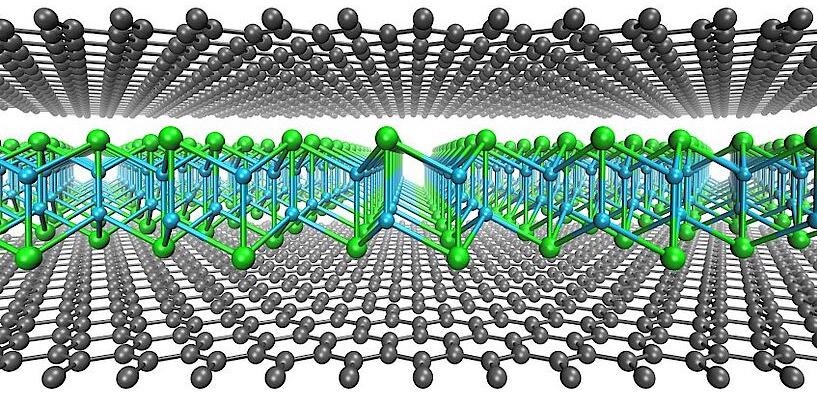The binding of atoms is done by sharing electrons. The process through which it happens not only relies on the atom types but also on conditions like pressure and temperature.
 A single layer of cuprous iodide encapsulated in between two sheets of graphene (gray atoms). Image Credit: ©2021 Kimmo Mustonen, Christoph Hofer und Viera Skákalov.
A single layer of cuprous iodide encapsulated in between two sheets of graphene (gray atoms). Image Credit: ©2021 Kimmo Mustonen, Christoph Hofer und Viera Skákalov.
As far as two-dimensional (2D) materials like graphene is concerned, atoms tend to join along a plane to develop structures that are just one atom thick.
This results in enchanting properties determined by quantum mechanics. Scientists at the University of Vienna in collaboration with the Universities of Tübingen, Antwerp and CY Cergy Paris, collectively with Danubia NanoTech, have generated a new 2D material created of copper and iodine atoms wedged between two graphene sheets. The study results were reported in the journal Advanced Materials.
The new materials’ design enables for either enhanced efficiency of familiar applications or completely new applications that were out of range with the earlier current materials. Tens of thousands of traditional materials like metals and their alloys have been identified over the past hundred years.
An equivalent number of feasible 2D materials have been anticipated to survive, but even now, just a fraction of them have been made in experiments. One reason for this is the instability of many of such materials in laboratory conditions.
In the recent study performed, the scientists synthesized 2D cuprous iodide that was stabilized in a graphene sandwich, as the first example of a material that does not differently exist in normal laboratory conditions.
The synthesis makes use of the great interlayer spacing of oxidized graphene multilayers, enabling copper and iodine atoms to spread into the gap and to grow the new material. The graphene layers here have an essential role in striking a high pressure on the fastened material that thus turns out to be stabilized. The consequent sandwich structure is displayed in the illustration.
As so often, when we first saw the new material in our microscopy images, it was a surprise. It took us quite some time to figure out what the structure precisely was. This enabled us together with Danubia NanoTech company, headed by Viera Skákalová, to design a chemical process for producing it in large scale.
Kimmo Mustonen, Study Lead Author, University of Viennna
Comprehending the structure was a collaborative measure of researchers from the Universities of Vienna, Tübingen, Antwerp and CY Cergy Paris.
“We had to use several electron microscopy techniques to make sure that we were really seeing a monolayer of copper and iodine and to extract the exact atom positions in 3D, including the latest methods we have recently developed,” added second lead author Christoph Hofer.
After the 2D copper iodide, the scientists have extended the synthesis technique to generate other new 2D materials.
The method seems to be truly universal, providing access to dozens of new 2D materials. These are truly exciting times.
Kimmo Mustonen, Study Lead Author, University of Vienna
Journal Reference:
Mustonen, K., et al. (2021) Toward Exotic Layered Materials: 2D Cuprous Iodide. Advanced Materials. doi.org/10.1002/adma.202106922.